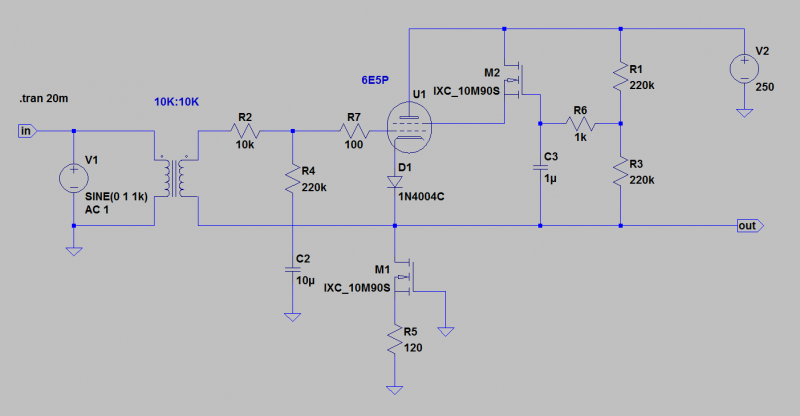here is a subtle variation of the “gm amplifier” arranged upside down. i’ve selected a fitting name for it, that reflects the post modern hybrid low life thinking beneath it. you should know by now this is something that just runs in the background of my brain all the time. the clever part is the screen arrangement. you get full pentode gain. the other finesse is negative feedback applied between ground and the “flying grid”. i am rather proud of this entire little puzzle. even if no one else is… ha!
you can of course replace the diode with a cathode resistor… i like the diode for a lot of reasons but the biggest is to avoid a bypass cap. a diode connected transistor would be an improvement. a mix of diode and resistor leaps out as a way to shape the harmonic content. and add degeneration to make tube selection less sensitive – always a good thing. and loading the output with a fixed R will adjust the gain. please note the output is wonderfully nested between the pentode and the current source: a programmable current source loaded by a fixed current source. it only looks like the reverse of the more plebian grounded cathode version… it is actually the same. however, there are still some small advantages to flipping it for real…
this is an actual gm amp and the gain is insanely high, as is the impedance. open loop gain is op-amp like and extremely useful. below are sweeps of the open loop and closed loop gain… please consider the quality of the input transformer as it will decide a great many things. a bifilar trans will NOT work. you need a “bridging” trans for this… balanced C and interleaved.
and… please note that the actual Q of the peak will be lower in practice. the diode has some impedance that will damp things a little. i would expect the peak to be 10dB less in reality. just 10 ohms in series with the diode will reduce the Q and the gain to something more like a gentle 6dB/octave slope and +90 dB at 250 Hz.
i’m going to stop here. hope someone out there gets something out of this, or at least gets it?
addendum
just to give a practical example of what makes this cool, i will add the following. who knows, i may end up expanding this because i like it so much?
adding a split supply allows an easy ground reference, that could even be servo-ed at the current source… you get a simple to direct-couple, low distortion driver stage. 40 volts peak to peak with 1 volt in (+28 dB). follow with a buffer and you can be sure it’s gonna work good.
below is a modeled fft. again it’s the trend that matters. i have built many other circuits like this with triodes, and in cascode, but never as a transconductance amplifier… even though this is the first, it’s a reliable method.





